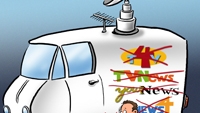I was surfing around on cable television the other night — just looking to see what was on, comparing different channels. Then I began thinking about how things have changed since early television.
My first TV set received only one station — channel 8, I think — and was black and white. When my family moved to another city, we could receive three channels — 3, 10 and 12. Three TV channels — wow! I thought television couldn't get any better. We could view three TV stations, each carrying a national network. What more could a viewer ever want?
Fast forward to today. I have more than 300 cable channels. All of them are color, and 20 are HD. And if all this linear delivery isn't enough, there is pay-per-view, video-on-demand, and premium sports and movie channels. I can spend a half hour just flipping through channels, looking for something to watch. Talk about interactive television.
In addition to the quality and quantity of broadcast television, something else has changed. OTA broadcasters are no longer “channels.” Today's broadcasters must support both analog and digital transmitters, each operating on a different RF channel. Should a station call itself “Channel 4” because it transmits analog on RF channel 4, or should it be “Channel 12” because it broadcasts digital on RF channel 12?

In addition, though many broadcasters might not want to think about it, perhaps 85 percent of their audience doesn't get their programming from those expensive transmitters anyway, but instead from cable. For them, the TV station's “channel number” means even less. Cable and satellite viewers may flip to 12 to watch OTA channel 4. If most of your viewers see you on cable channel 213, why would you promote yourself as “News 4”?
Let's rethink how stations should brand themselves. Station WCBS-TV, channel 2, in New York might become WCBS, or just CBS. Who cares what RF channel a station uses any more?
Plus, viewers increasingly expect to consume their TV programs on multiple platforms, including the Web, portable viewers like iPods or Zunes, and perhaps even cell phones. None of these devices recognize OTA channel numbering. These factors combine to make a station's OTA channel number almost meaningless for branding
The professional video industry's #1 source for news, trends and product and tech information. Sign up below.
Some of you may remember when phone numbers began with a two-syllable name preface. Examples include Murray, abbreviated MU; Whitehall, WH; and Stetson, SS. A five-digit number followed these letters. The abbreviation stood for numbers on the telephone dial. Murray's MU was for 6 and 8. Whitehall's WH was for 9 and 4. That's why telephones dials were marked with numbers and the alphabet in the first place, as surprising as that may be to the text-messaging generation.
In the late '60s, alpha prefixes were dropped and replaced with the matching numbers. Whitehall 3-7446 became 943-7446. The phone number didn't change — only what we called it. It'll be the same for broadcasters.
A reader once signed his letter to me with something like, “WZYZ-TV, CBS News Center 4, Springfield.” The station was clearly trying to identify itself in as many ways as possible — possibly too many. Soon, branding will need to market to the core image of a station, not just the station's OTA channel number.
So, next time the ENG trucks need painting, think about using cheap paint. You may have to change that station logo sooner than you think.
EDITORIAL DIRECTOR
Send comments to:editor@penton.com
